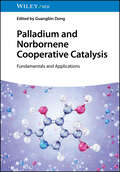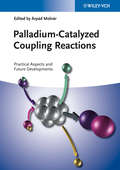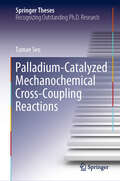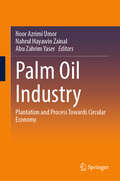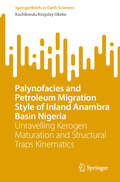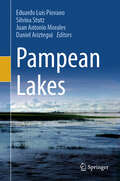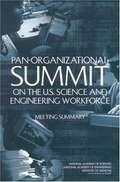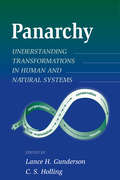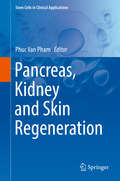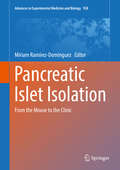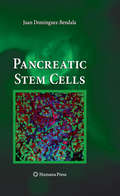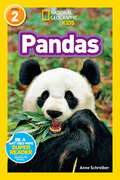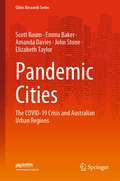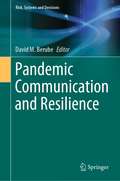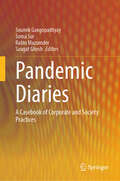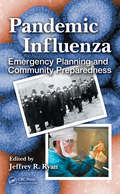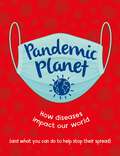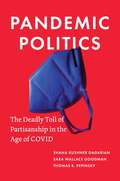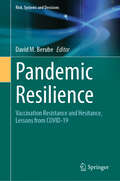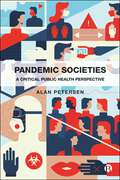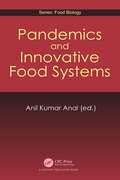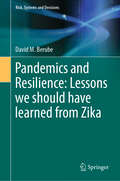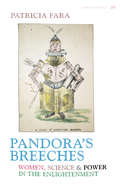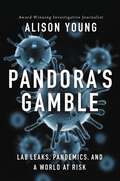- Table View
- List View
Palladium and Norbornene Cooperative Catalysis: Fundamentals and Applications
by Guangbin DongA comprehensive exploration of Pd/Norbornene (NBE) catalysis In Palladium and Norbornene Cooperative Catalysis: Fundamentals and Applications, renowned researcher Professor Guangbin Dong delivers a systematic and comprehensive discussion of Pd/NBE catalysis, including its mechanisms, scopes, applications, and current limitations. The book provides readers with the fundamental knowledge they will need to use this type of catalysis in their own research, as well as how to choose the best reaction conditions and catalyst combinations. Each of the eight chapters are written by leading experts in the Pd/NBE catalysis field. They cover topics ranging from the mechanistic foundation of Pd/NBE catalysis to the scope of the ipso and ortho functionalization, asymmetric development, a review of the Pd/NBE-catalyzed heteroarene functionalization, and more. Readers will also find: A thorough introduction to intramolecular and intermolecular cyclizationsComprehensive explorations of the annulation chemistryPractical discussions of Pd(II)-initiated reactionsA complete summary of a variety of applications in the synthesis of complex molecules and organic materials using Pd/NBE catalysis Perfect for chemistry students with an interest in transition-metal catalysis and organic synthesis. This book will also benefit academic researchers and practicing chemists.
Palladium-Catalyzed Coupling Reactions
by Árpád MolnárThis handbook and ready reference brings together all significant issues of practical importance in selected topics discussing recent significant achievements for interested readers in one single volume. While covering homogeneous and heterogeneous catalysis, the text is unique in focusing on such important aspects as using different reaction media, microwave techniques or catalyst recycling. It also provides a comprehensive treatment of key issues of modern-day coupling reactions having emerged and matured in recent years and emphasizes those topics that show potential for future development, such as continuous flow systems, water as a reaction medium, and catalyst immobilization, among others.With its inclusion of large-scale applications in the pharmaceutical industry, this will equally be of great interest to industrial chemists.From the contents* Palladium-Catalyzed Cross-Coupling Reactions - A General Introduction* High-turnover Heterogeneous Palladium Catalysts in Coupling Reactions: the Case of Pd Loaded on Dealuminated Y Zeolites Palladium-Catalyzed Coupling Reactions with Magnetically Separable Nanocatalysts* The Use of Ordered Porous Solids as Support Materials in Palladium-Catalyzed Cross-Coupling Reactions* Coupling Reactions Induced by Polymer-Supported Catalysts* Coupling Reactions in Ionic Liquids* Cross-Coupling Reactions in Aqueous Media* Microwave-Assisted Synthesis in C-C and C-Heteroatom Coupling Reactions* Catalyst Recycling in Palladium-Catalyzed Carbon-Carbon Coupling Reactions* Nature of the True Catalytic Species in Carbon-Carbon Coupling Reactions with* Heterogeneous Palladium Precatalysts* Coupling Reactions in Continuous Flow Systems* Large-Scale Applications of Palladium-Catalyzed Couplings in the Pharmaceutical Industry
Palladium-Catalyzed Mechanochemical Cross-Coupling Reactions (Springer Theses)
by Tamae SeoIn this thesis, the author developed cross-coupling reactions that proceed in the solid state without using organic solvents, utilizing a mechanochemical synthesis method using a ball mill. Compared to conventional solution systems, the reactions realized a drastic reduction of chemical waste, a drastic acceleration of chemical reactions, and efficient transformations of insoluble compounds. The thesis demonstrates that mechanochemical synthesis method has the potential to revolutionize organic synthesis. Readers can learn not only about mechanochemical synthesis but also about new reactions and syntheses of new compounds that could not be obtained under solution conditions. Recently, mechanochemical synthesis has become increasingly popular among a wide range of researchers as an environmentally friendly and highly efficient method, so this thesis has a timely publication.
Palm Oil Industry: Plantation and Process Towards Circular Economy
by Abu Zahrim Yaser Noor Azrimi Umor Nahrul Hayawin ZainalThis book highlights current efforts and research on sustainable solutions for the palm oil industry, including production and waste management. It provides an overview of sustainable principles and practices within the industry and explores ongoing initiatives to utilize various oil palm waste. In addition to extraction of lignin and cellulose, the book also discusses the use of oil palm biomass for environmental remediation.
Palynofacies and Petroleum Migration Style of Inland Anambra Basin Nigeria: Unravelling Kerogen Maturation and Structural Traps Kinematics (SpringerBriefs in Earth Sciences)
by Kachikwulu Kingsley OkekeThis book highlights a detailed high-resolution palynofacies origin and depositional environment, source rock potential, hydrocarbon migration pathway and structural hydrocarbon entrapment mechanisms of the outcrop lithostratigraphic units of the inland Anambra basin. It broadens readers’ geoscientific conceptualization in the appraisal of the quantity and quality of outcrop scale, generated chemical macerated palynofacies elements and kerogen maturation synthesis, palynofacies hydrodynamics and sedimentary structures trapping orientation and configurations, structural mechanics and lateral facies changes. This boils down to perfect comprehension of the sedimentary, palaeontological data and natural plant evolution, growth and depositional processes in order to authenticate their origin and provenance, depositional environment and hydrocarbon production potential within the context of the basin. Presence of texturally mature coarse- to fine-grained sandstones, variable sedimentary structures, internal bed geometries and nature of bedding, age and palynofacies hydrodynamics are vital prognostic stratigraphic and paleoenvironment indices culminated in the kerogen types, organic thermal maturation, seals and reservoir rock quality along with kinematics-driven faults and joints in time and space. These geoscientific concepts were summarily authenticated in the specific objectives and chapter series of this book along with modelled prognosis for potential conventional and unconventional hydrocarbon prospects to contribute more information to oil exploration campaign in the inland basin.
Pampean Lakes
by Juan Antonio Morales Daniel Ariztegui Eduardo Luis Piovano Silvina StutzThis book is for advanced students, researchers and professionals from Earth and Environmental Sciences. The Argentinean Pampa plain is an extensive region of ca 673,000 km2 between 30°S and 38°S in South America. The region encompasses a large number of lakes (>50,000) of highly variable sizes. Pampean lakes have been very sensitive to past and recent climatic change. Thus, paleolimnological research across the Pampa plain provides unique insights into regional environmental variability since the Late Pleistocene up to the most recent hydroclimatic changes. These lakes are sensors of both the documented increase in precipitation that occurred after the 1970´s seventies as well as substantial changes in land use It compiles the most outstanding information of the region for the last 30 years regarding ecological aspects, changes in land-use processes and their impact on water bodies, paleolimnological reconstructions, archeology, hydroclimatic variability and associated human dimension. This knowledge provides environmental information that is fundamental to develop integrated water management projects.
Pan-organizational Summit On The U.s. Science And Engineering Workforce: Meeting Summary
by Marye Anne FoxEach of 32 nonprofit organizations contributing a presentation to the Pan-Organizational Summit on the Science and Engineering Workforce (November 11-12, 2002; The National Academies, Washington, DC) was invited to issue a corresponding position paper to be reproduced in this volume. The bulk of this report comprises these papers. In addition, Shirley Jackson and Joseph Toole, two of the keynote speakers, have included their remarks.
Panarchy: Understanding Transformations in Human and Natural Systems
by C. S. Holling Lance H. GundersonCreating institutions to meet the challenge of sustainability is arguably the most important task confronting society; it is also dauntingly complex. Ecological, economic, and social elements all play a role, but despite ongoing efforts, researchers have yet to succeed in integrating the various disciplines in a way that gives adequate representation to the insights of each.Panarchy, a term devised to describe evolving hierarchical systems with multiple interrelated elements, offers an important new framework for understanding and resolving this dilemma. Panarchy is the structure in which systems, including those of nature (e.g., forests) and of humans (e.g., capitalism), as well as combined human-natural systems (e.g., institutions that govern natural resource use), are interlinked in continual adaptive cycles of growth, accumulation, restructuring, and renewal. By understanding these cycles and their scales, researchers can identify the points at which a system is capable of accepting positive change, and can use those points to foster resilience within the system.This volume brings together leading thinkers on the subject to develop and examine the concept of panarchy and to consider how it can be applied to human, natural, and human-natural systems. Throughout, contributors seek to identify adaptive approaches to management that recognize uncertainty and encourage innovation while fostering resilience.The book is a fundamental new development in a widely acclaimed line of inquiry. It represents the first step in integrating disciplinary knowledge for the adaptive management of human-natural systems across widely divergent scales, and offers an important base of knowledge from which institutions for adaptive management can be developed. It will be an invaluable source of ideas and understanding for students, researchers, and professionals involved with ecology, conservation biology, ecological economics, environmental policy, or related fields.
Pancreas, Kidney and Skin Regeneration
by Phuc Van PhamThis invaluable resource discusses clinical applications with effects and side-effects of applications of stem cells in diabetes, kidney and wound treatment. All chapters are contributed by pre-eminent scientists in the field and covers such topics as stem cells and cell therapy in the treatment of diabetes mellitus, kidney failure, wound and other skin aging diseases, characteristics of some kinds of stem/progenitor cells for therapy, future directions of the discussed therapies and much more. Pancreas, Kidney and Skin Regeneration and the other books in the Stem Cells in Clinical Applications series will be invaluable to scientists, researchers, advanced students and clinicians working in stem cells, regenerative medicine or tissue engineering.
Pancreatic Islet Isolation
by Miriam Ramírez-DomínguezPancreatic islets make up the endocrine pancreas and they contain the only source of insulin in the body, beta cells. Hence, access to high quality preparations of pancreatic islets is fundamental for in vitro studies and to test pre-clinical applications in animal models in vivo. Access to healthy human islets is also crucial to improve transplantation procedures for diabetes. Given the susceptibility of pancreatic islets to the enzymatic digestion and mechanical stress required to obtain them, the isolation of islets is often considered as the delicate "work of a craftsman". This book, which is aimed at beginners and experts alike, is a survey of the current state-of-the-art in this field and it centres on the challenges, pitfalls and peculiarities of pancreatic islet isolation in the different species used in pre-clinical and clinical applications. It explores the similarities and differences between human islets and those from other relevant species (rodents, pigs and non-human primates), and how these influence islet isolation. The ultimate goal of this book is to improve the outcome of islet isolation and transplantation in pre-clinical and clinical applications.
Pancreatic Stem Cells
by Juan Domínguez-BendalaFrom the discovery of Pdx1, the first "master gene" of pancreatic development, to the most recent findings on the role of microRNAs in beta cell homeostasis, the last fifteen years have seen an unprecedented advance in our understanding of the precise development and organization of the many different cell types that make up the pancreas. It is now widely acknowledged that the therapeutic differentiation of stem cells into pancreatic cells is an ambitious endeavor that will not succeed without a thorough understanding of the molecular processes underlying the native development of the organ. This book, aimed at experts and students alike, offers a comprehensive review of the state of the art in both pancreatic development and regeneration. The many strategies to differentiate adult and embryonic stem cells into pancreatic beta cells are also discussed in the context of potential therapeutic interventions for type I diabetes.
Pandas (Readers)
by Anne SchreiberThe whole world loves panda bears. Everyone loves to watch them play, climb, cuddle, and chew. But careful, they can scratch too—just look at that tree! Pandas live in wild places very far away, and they are the STAR ATTRACTIONS of every zoo that keeps them safe and well, all over the world.National Geographic supports K-12 educators with ELA Common Core Resources.Visit www.natgeoed.org/commoncore for more information.
Pandemic Cities: The COVID-19 Crisis and Australian Urban Regions (Cities Research Series)
by Elizabeth Taylor John Stone Emma Baker Amanda Davies Scott BaumThis book highlights the impact of the COVID-19 pandemic on cities. The COVID-19 pandemic and the associated economic and social impacts have been felt around the world. In large cities and other urban areas, the pandemic has highlighted a number of issues from pressures on urban labour and housing markets, shifts in demographic processes including migration and mobility, changes in urban travel patterns and pressures on contemporary planning and governance processes. Despite Australia’s relatively mild COVID exposure, Australian cities and large urban areas have not been immune to these issues. The economic shutdown of the country in the early stages of the pandemic, the sporadic border closures between states, the effective closure of international borders and the imposition of widespread public health orders that have required significant behavioural change across the population have all changed our cities in some and the way we live and work in them in some way. Some of the challenges have reflected long-standing problems including intrenched inequality in labour markets and housing markets, others such as the impact on commuting patterns and patterns of migration have emerged largely during the pandemic. This book, co-authored by experts in their field, outlines some of the major issues facing Australian cities and urban areas as a result of the pandemic and sets a course for future of the cities we live in.
Pandemic Communication and Resilience (Risk, Systems and Decisions)
by David M. BerubeThis book examines how we design and deliver health communication messages relating to outbreaks, epidemics, and pandemics. We have experienced major changes to how the public receives and searches for information about health crises over the last twelve decades with the ongoing shift from text/broadcast-based to digital messaging and social media. Both health theories and practices are examined as it applies to testing, tracking, hoarding, therapeutics, and vaccines with case studies. Challenges to communicate about health to diverse audiences (including the science illiterate) and across (both Western and developing economies) have been complicated by politics, norms and mores, personal heuristics, and biases, such as mortality salience, news avoidance, and quarantine fatigue. Issues of economic development and land use, trade and transportation, and even climate change have increased the exposure of human populations to infectious diseases making risk and resilience more pressing. The book has been designed to support health communicators and public health management professionals, students, and interested stakeholders and university libraries.
Pandemic Diaries: A Casebook of Corporate and Society Practices
by Rabin Mazumder Soumik Gangopadhyay Soma Sur Saugat GhoshThis book provides valuable insights into the challenges faced by businesses striving for survival during the COVID-19 pandemic. It presents the grave issues encountered during the pandemic, highlighting the threats and the strategies adopted to seize opportunities in adversity. Through a case-based approach, the book explores recent trends, issues, and best practices in Corporate Governance, Corporate Social Responsibility, Information Technology, Psychological Stability, Marketing, Human Resource Management, and Sustainability. The primary objective of this book is to help readers comprehend the strategic management practices essential for business survival during times of crisis. It examines the innovative approaches and practices adopted by businesses during the pandemic and evaluates their effectiveness in ensuring sustainability. The authors analyze sustainable issues from both subjective and objective dimensions, offering a comprehensive understanding of sustainable practices in the corporate world. Each chapter of the book presents strategic applications of innovative practices and trends in various management fields. The narratives present strategic case studies in marketing management, human resource management, financial management, and supply chain management, providing valuable insights for aspiring managers, practitioners, and researchers alike.
Pandemic Influenza: Emergency Planning and Community Preparedness
by Jeffrey R. RyanThe swine flu emergency needn‘t become a crisis. This critically acclaimed work provides public health officials, doctors, responders, and emergency planners with accurate current information that will help them understand the nature of an outbreak, assess risk, answer public concerns, and develop informed strategies. Devoid of sensationalism and a
Pandemic Planet: How diseases impact our world (and what you can do to help stop their spread)
by Anna ClaybournePandemic Planet gives young readers a clear, insightful, non-alarmist introduction to viruses and pandemics.Covid-19 has changed our world almost beyond recognition, but viruses and pandemics have always been with us. Pandemic Planet explores how we define pandemics, describes pandemics through the ages, from the Black Death to SARS, and assesses how we can arm ourselves against them, both at an individual and a global level.The matter-of-fact, clear and non-alarmist approach will reassure anxious readers. The book also looks at how we can learn from pandemics, as well as revealing some unexpectedly positive outcomes.Following on from Plastic Planet and Hot Planet, Pandemic Planet will feature the same blend of illustrations and photos and a striking cover, and is written by the award-winning science author Anna Claybourne.Aimed at readers aged 9 plusContents:1: Worldwide crisis2: What does 'pandemic' mean?3: Germs and diseases4: Pandemics of the past5: CASE STUDY: The Black Death 6: Immunity7: The early stages8: Out of control9: CASE STUDY: The 1918-19 flu pandemic10: Lockdown!11: Pandemic problems12: CASE STUDY: Covid-1913: Finding a solution14: Back to normal15: Preventing and preparing16: What can you do?17: Antibiotics alert!18: CASE STUDY: Antibiotic-resistant TB19: Pandemic planet?20: The positives21: Glossary22: Further reading23: Index
Pandemic Planning
by David R. Black J. Eric DietzPreparedness and rigorous planning on community, state, and regional levels are critical to containing the threat of pandemic illness. Steeped in research and recommendations from lessons learned, Pandemic Planning describes the processes necessary for the efficient and effective preparation, prevention, response, and recovery from a pandemic threa
Pandemic Politics: The Deadly Toll of Partisanship in the Age of COVID
by Thomas B. Pepinsky Sara Wallace Goodman Shana Kushner GadarianHow the politicization of the pandemic endangers our lives—and our democracyCOVID-19 has killed more people than any war or public health crisis in American history, but the scale and grim human toll of the pandemic were not inevitable. Pandemic Politics examines how Donald Trump politicized COVID-19, shedding new light on how his administration tied the pandemic to the president’s political fate in an election year and chose partisanship over public health, with disastrous consequences for all of us.Health is not an inherently polarizing issue, but the Trump administration’s partisan response to COVID-19 led ordinary citizens to prioritize what was good for their “team” rather than what was good for their country. Democrats, in turn, viewed the crisis as evidence of Trump’s indifference to public well-being. At a time when solidarity and bipartisan unity were sorely needed, Americans came to see the pandemic in partisan terms, adopting behaviors and attitudes that continue to divide us today. This book draws on a wealth of new data on public opinion to show how pandemic politics has touched all aspects of our lives—from the economy to race and immigration—and puts America’s COVID-19 response in global perspective.An in-depth account of a uniquely American tragedy, Pandemic Politics reveals how the politicization of the COVID-19 pandemic has profound and troubling implications for public health and the future of democracy itself.
Pandemic Resilience: Vaccination Resistance and Hesitance, Lessons from COVID-19 (Risk, Systems and Decisions)
by David M. BerubeThis edited volume draws from health communication scholars and offers a depthful examination of the roles vaccination have played and continue to play in contributing to human, community, and transnational protection against infectious diseases. The problems associated with vaccination against infection diseases was made abundantly clear during the current pandemic of COVID-19. Vaccines were traced back to Dr. Edward Jenner in the 18th century as a tool to control smallpox in England. Today we have six different categories of vaccines (three seem most controversial today): inactivated, live-attenuated, and messenger RNA (mRNA). We examine the reasons for public reluctance and outright resistance to vaccines examining cognitive biases, communication campaign failures, politicization, misinformation, partisanship, and greed. The healthcare industry has not treated all infected people equally, especially the poor and people of color. This is true in the USA as well as abroad. In the future, we can expect more exotic infections to increase due to globalization, development, and transportation. As climate changes, humans will contact more species carrying many different bacteria and viruses. Advances in medical research have led to increases in the number of vaccinations available to control infection and outbreaks. However, the rates of vaccination have fluctuated over time. A vaccine that is not used is meaningless. To increase vaccination rates, we must learn why the public shies away from vaccinations and under what circumstances. This information will enable us to design more effective messaging and communication campaigns to maximize general resilience. An interactive partnership between providers of healthcare and their patients is a prerequisite to productive and effective vaccination campaigns
Pandemic Societies: A Critical Public Health Perspective
by Alan PetersenFrom SARS to Zika, and Ebola to COVID-19, epidemics and pandemics have become increasingly prevalent in recent years. Each outbreak presents new challenges but the responses are often similar. This important book explores the dimensions, dynamics and implications of emerging pandemic societies. Drawing on ideas from sociology and science and technology studies, it sheds new light on how pandemics are socially produced and, in turn, shape societies in areas such as governance, work and recreation, science and technology, education, and family life. It offers pointers to the future of pandemic societies, including the expansion of technologies of surveillance and control, as well as the prospects of social renewal created by economic and social disruption.
Pandemics and Innovative Food Systems (Food Biology Series)
by Anil Kumar AnalThe debate on health, nutrition and food security could not have arisen at a more opportune time. The recent pandemic has given rise to increased food and nutrition insecurity for individuals, families, and communities. The crisis threatened the food security and nutrition of millions of people, many of whom were already suffering. We face possible disruptions to the functioning of food systems, with severe consequences for health and nutrition. Pandemics create a greater burden for poorer countries and countries since they are already pressure of inadequate food supplies. With concerted action, we can not only avoid some of the worst impacts but do so in a way that supports a transition to more sustainable food systems that are in better balance with nature and that support healthy diets – and thus better health prospects for all. This book aims to highlight the impact of pandemics in food systems and nutrition security. It draws on the experience from the past and present pandemics to better prepare the world for future crises.
Pandemics and Resilience: Lessons we should have learned from Zika (Risk, Systems and Decisions)
by David M. BerubeThe aim of the book was to produce the most comprehensive examination of a pandemic that has ever been attempted. By cataloging the full extent of the Zika pandemic, this book will be the most complete history and epistemic contextualization ever attempted to date. The work should function as the primary source for students, researchers, and scholars who need information about the Zika pandemic. This book examines the technical literature, digital and popular literature, and online materials to fully contextualize this event and provide a bona fide record of this event and its implications for the future. It is somewhat serendipitous that while this work was underway, we are going through another pandemic. One of the primary lessons we did not learn by Zika was pandemic events will return repeatedly, and we need to learn from each one of them to prepare the planet for the next one. Just because Zika seemed to have died out does not make it less important. We were lucky that the virus evolved into what seemed to be a less virulent version of itself, and the vector mosquitoes were concentrated elsewhere. Finally, this book represents a tour de force in scholarship involving nearly 4,000 sources of information and does not shy from a detailed examination of the controversies, conspiracies, and long-term consequences when we avoid learning from outbreaks, such as Zika.
Pandora's Breeches: Women, Science and Power in the Enlightenment
by Patricia Fara'Had God intended Women merely as a finer sort of cattle, he would not have made them reasonable.' Writing in 1673, Bathsua Makin was one of the first women to insist that girls should receive a scientific education. Despite the efforts of Makin and her successors, women were excluded from universities until the end of the nineteenth century, yet they found other ways to participate in scientific projects.Taking a fresh look at history, Pandora's Breeches investigates how women contributed to scientific progress. As well as collaborating in home-based research, women corresponded with internationally-renowned scholars, hired tutors, published their own books and translated and simplified important texts, such as Newton's book on gravity. They played essential roles in work frequently attributed solely to their husbands, fathers or friends.
Pandora's Gamble: Lab Leaks, Pandemics, and a World at Risk
by Alison YoungNamed to Kirkus Reviews&’ Best Books of 2023 A &‘remarkable book.&’ – The New York TimesThis fearless, deeply reported book about laboratory accidents asks the haunting question some elite scientists don&’t want the public to entertain: Did the COVID-19 pandemic start with a lab leak in Wuhan, China? This is an obvious question. Yet there&’s been an extraordinary effort by government officials in China, as well as leading scientific experts in the United States and around the world, to shut down any investigation or discussion of the lab leak theory. In private, however, some of the world&’s elite scientists have seen a lab accident as a very real and horrifying possibility. They know what the public doesn&’t. Lab accidents happen with shocking frequency. Even at the world&’s best-run labs. That&’s among the revelations from Alison Young, the award-winning investigative reporter who has spent nearly 15 years uncovering shocking safety breaches at prestigious U.S. laboratories for USA Today and other respected news outlets. In Pandora&’s Gamble, Young goes deep into the troubling history -- and enormous risks -- of leaks and accidents at scientific labs. She takes readers on a riveting journey around the world to some of the worst lab mishaps in history, including the largely unknown stories of the lab workers at the U.S. Army&’s Camp Detrick who suffered devastating infections at alarming rates during World War II. And her groundbreaking reporting exposes for the first time disturbing new details about recent accidents at prestigious laboratories – and the alarming gaps in government oversight that put all of us at risk. Sourced through meticulous reporting and exclusive interviews with key players including Dr. Anthony Fauci, former CDC Director Tom Frieden and others, Young&’s examination reveals that the only thing rare about lab accidents is the public rarely finds out about them. Because when accidents happen, powerful people and institutions often work hard to keep the information secret.
